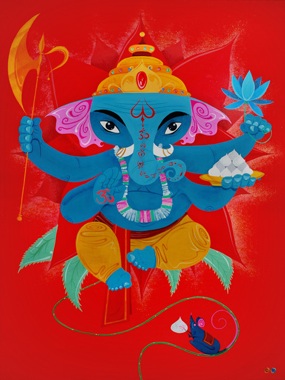
I used to have this pink bracelet I ‘borrowed’ from a co-counseler at summer camp about four years ago that I never actually returned. It was leather, studded with rhinestones and I really liked it until I lost it at a Los Abandoned show. This was back when a bunch of emo bands were getting huge and for about five minutes it was cool for dudes to rock pink stuff.
The color pink is a major theme in Buff Monster’s work, serving as a primary emotional impetus in Heavy Metal Ice Cream Smile, his new show at the Corey Helford Gallery. The artist has highlighted (pun, booyah) the auspicious color of pink in Asian cultures by displaying throbbing shades of it in digitally perfect landscapes with huge Japanese lettering soaring over the mountaintops and with ubiquitous smiling ghost cherubs with anime-esque eyes dripping in everything from a pale red to a flushed neon salmon.
Mr. Monster used wooden panels mainly. Actually, with the exception of the huge inflated ice cream cone installation (there were free ice cream cones handed out at the opening) I might go on to say exclusively. Not to be gauche, but the pop-surrealism-slash-skateboard-design-on-wood-panel trend was officially spotted by yours truly when I purchased Chapo’s ‘The Obedient’ last year while at the Downtown Art Walk. Not a big deal, but apparently I know what’s awesome (which is, I presume, why you’re reading this blog). It turns out that art on wooden panels is visually pleasing, especially when the art is so focused on purely imaginative subject matter, creating a visual schism between the tangibly real and animated hyper-fantasy. In ‘Slippery Sundae’ an ice cream mountain oozes pink rivers of sugary lava as joyous nipple-tipped phalluses sway about under a sky composed of natural, untouched wood. The dichotomy is unmistakable.
Sometimes Monster appropriates other ideas from fellow street artists such as Banksy and Mr. Brainwash by incorporating his giggly spectral figures into what would otherwise be romantic landscapes from the late Baroque period. Banksy weaves his modern figures into the pieces whereas in ‘Expulsion From Eden’ a grey ghost glossed in some kind of viscera explodes over the painting without regard to the waterfalls, horse-drawn wagons or scenic vistas.
The artist says he listened to heavy metal while painting, which would explain not only the awesome music playing at the reception (Sweet Child O’ Mine, Pour Some Sugar On Me, etc.) but the skull and pentagram motifs that found their way into the work. Some paintings were grey, satanic realizations of Buff Monster’s lollipop ideal yet were driven nonetheless by the same buoyant adolescent enthusiasm. My favorite of these (perhaps of the whole show) was ‘Skull Camouflage’, a work that stuck out as the only one to not feature recognizable figures or features. It was a panel of grey and white camouflage and the only thing that made it Buff Monster was one curving swirl of color in the shape of his idiomatic skull illustration. Maybe after all the ice cream and smiles I found this one the most brutal and thus... the most metal.
Heavy Metal Ice Cream Smile runs at the Corey Helford Gallery until October 2nd.





